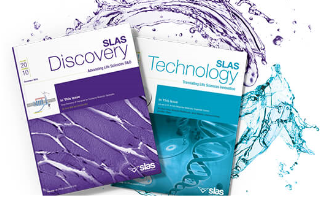By Alan E. Fletcher, Ph.D.
October 30, 2019
It takes the talent and scientific know-how of nearly 1,000 volunteers each year to publish SLAS’s two scientific journals, SLAS Discovery and SLAS Technology. This includes authors, reviewers, Editorial Board members and editors – all with the goal of presenting the very best in peer-reviewed research for our specialized audience.
As we near the end of 2019, we have already published 1,470 pages in our two journals, with the December issues yet to come. SLAS Discovery, under the watchful eye of Editor-in-Chief Robert M. Campbell, Ph.D., Eli Lilly and Company, focuses on how scientists develop and utilize novel technologies and/or approaches to provide and characterize chemical and biological tools to understand and treat human disease. SLAS Technology explores ways in which scientists adapt advancements in technology for scientific exploration and experimentation. Editor-in-Chief Edward Kai-Hua Chow, Ph.D., National University of Singapore, champions this publication. You cannot find better advocates for our scientific publications!
I am always amazed by the accomplishments of Bob and Ed, year in year out, in partnership with SAGE Publishing. These two thought-leading scientists are expert at uncovering important work being done throughout the world and encouraging highly talented researchers to share their findings. They bring together a diverse group of contributors and ensure that published material is accurate and meaningful. Thank you Bob and Ed!
The SLAS Discovery Editorial Board and SLAS Technology Editorial Board believe in the power of special issues or special collections to present deep dives into important scientific areas. Likewise, the successful response to these issues measured by downloads, clicks and citations, shows that readers find them powerful too. The following special issues have been published in 2019:
Advances in 3D and Organoid Cell Culture (SLAS Technology, February)
Academic Screening Centers and Translational Drug Discovery Centers Showcase (SLAS Discovery, March)
Nanoparticle Strategies for Biomedical Applications (SLAS Technology, April)
The Science of Sample Management: Enabling Discovery from Bench to Clinic (SLAS Technology, June)
Engineering Innovations for Fundamental Biology and Translational Medicine (SLAS Technology, October)
Membrane Proteins: New Approaches to Probes, Technologies and Drug Design (SLAS Discovery, October and December)
These issues have been well received, and more are in the works for the future. Several 2020 and 2021 issues remain open to accepting your submission, and I encourage you to do so according to your area of expertise.
Flexible Analytical Devices for Point-of-Care Testing (SLAS Technology, February 2020)
Advances in Cellular Target Engagement and Target Deconvolution (SLAS Discovery, February 2020)
Carbohydrate Structure Analysis: Methods and Applications (SLAS Technology, 2020)
Functional Genomics for Target Identification (SLAS Discovery, 2020)
Hit Discovery Methodology (SLAS Discovery, 2021) Currently accepting proposals
Early Drug Discovery Approaches with More Physiologically Relevant Targets (SLAS Discovery, 2021) Currently accepting proposals
High-Content Imaging and Informatics: Joint Special Issue with SBI2 & SLAS (SLAS Discovery, 2020) Currently accepting proposals
AI in Process Automation (SLAS Technology, 2021) Currently accepting proposals Advances in Protein Degradation (SLAS Discovery, 2021)
Other topics being explored by SLAS Editorial Boards include bioinformatics, broaderOMICS, target engagement, genome editing, internet of things and immune-oncology. In addition, please know that the Editorial Boards are open to considering proposals for special collections.

SLAS looks forward to introducing conference issues beginning with SLAS2020. Both SLAS Discovery and SLAS Technology will target manuscript solicitation from impactful scientific program presentations that are applicable to journal readership. These papers will be held to the same high standards and full peer review as with all submitted manuscripts.
This new approach makes sense to me. Every year at the SLAS International Conference and Exhibition, we experience incredible presentations by leading voices in the field. Extending the reach of the work presented at conference in a follow-up scientific paper continues the learning.
If you are ready to submit your work to the SLAS journals, visit the Author Instructions webpage.
If you don’t have original research ready for publication right now, consider preparing an editorial, review or perspective article. Contact Ally Jump, SLAS Publishing Manager for more information.
The SLAS Call for Volunteers is open and it includes positions on the SLAS Discovery and SLAS Technology Editorial Boards. Moreover, if you’d like to volunteer to serve as a manuscript reviewer, read the Guidelines for SLAS Manuscript Reviewers, and register as a user at SLAS Discovery SAGE Track and/or SLAS Technology SAGE Track.
Not sure yet? Visit the Scientific Journals page on the SLAS website to see how you might contribute. You will be glad you did.